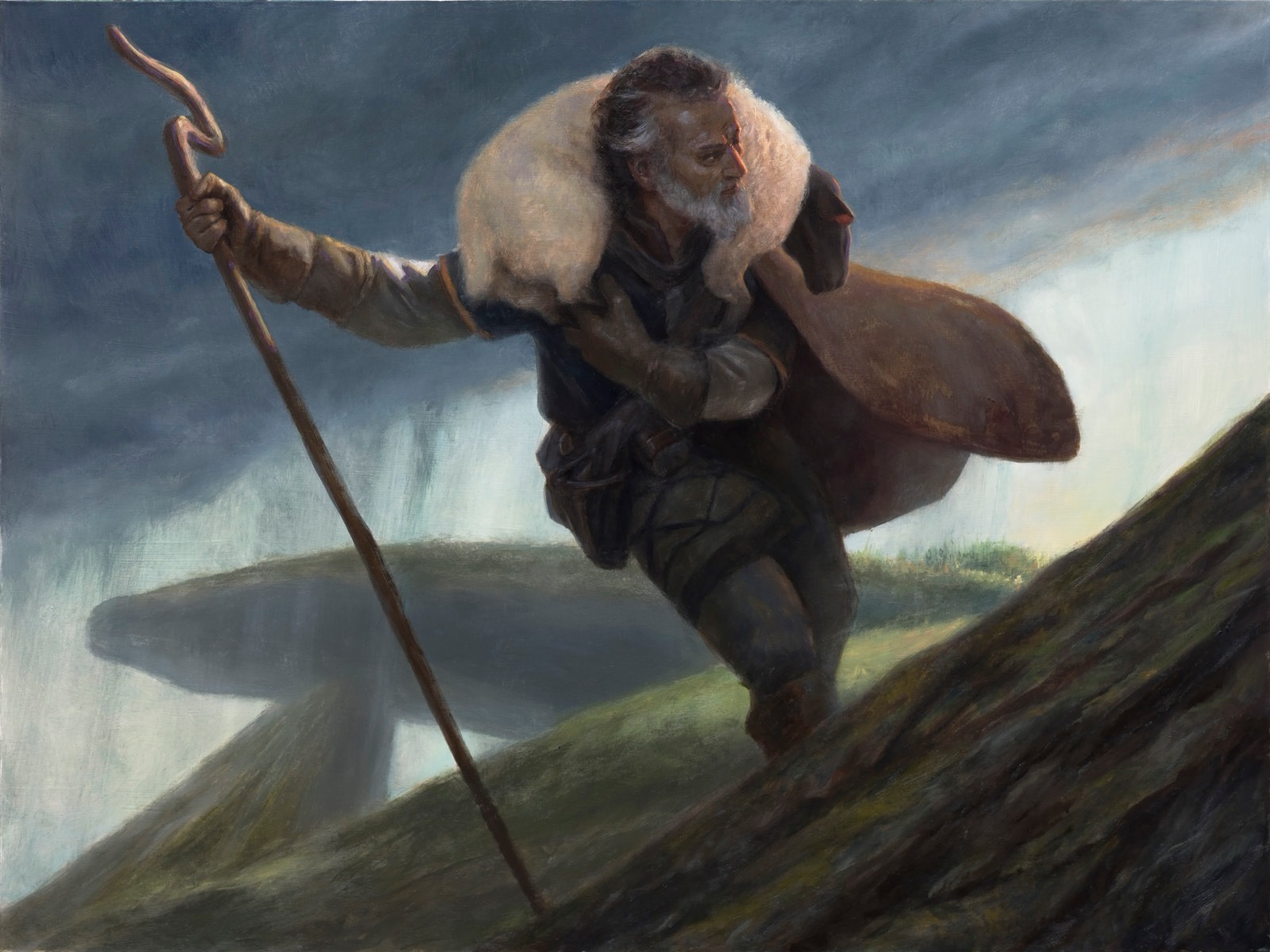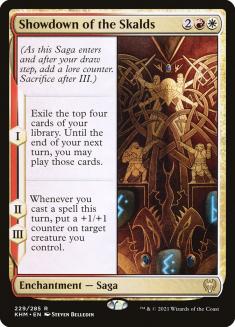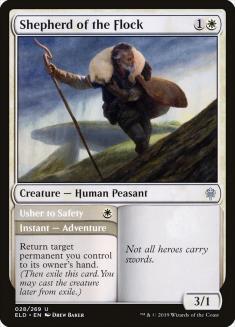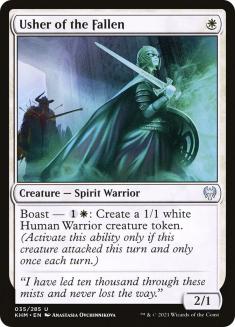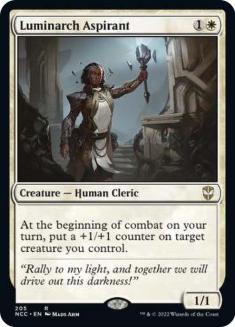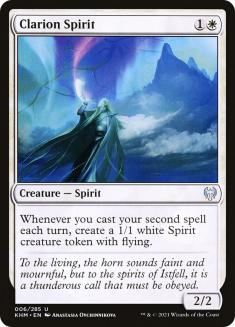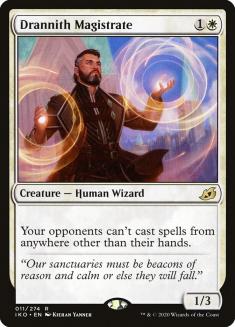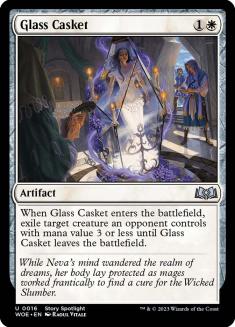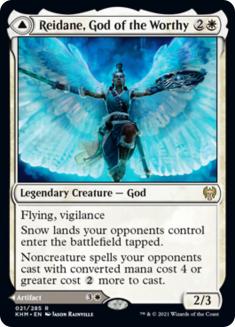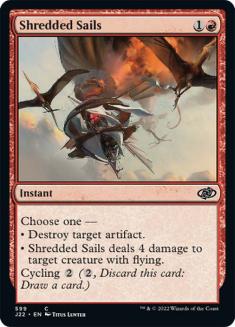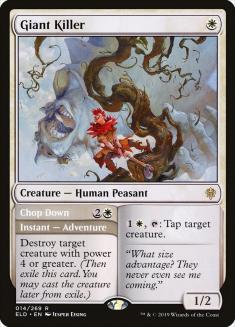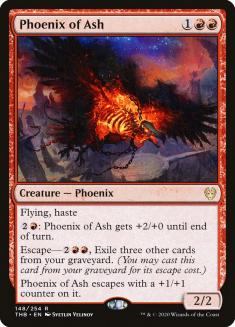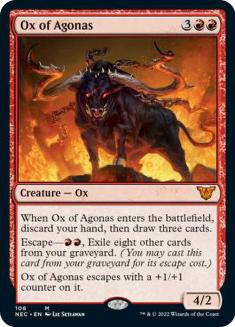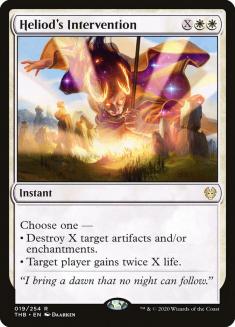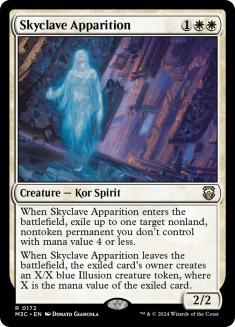Showdown of the Skalds was one of the most hotly debated cards during Kaldheim preview season. At this point, it’s very clear that those who saw its potential were in the right. Showdown spawned multiple new archetypes and has been splashed into countless others. It gives aggressive decks an engine and can even be used to good effect alongside Yorion, Sky Nomad and Genesis Ultimatum.
Michael Majors covered the combo-ish Naya build earlier this week. Since he got to talk about the fun stuff, I suppose I’ll settle for the tried-and-true “attack for two” version. Believe it or not, I have a history with medium white aggressive decks, especially those that are disruptive and have resiliency. If you can become the control deck against opposing creature decks, even better.
Skyclave Apparition provides the necessary utility and Seasoned Hallowblade does most of the heavy lifting. Showdown of the Skalds was the last piece of the puzzle. Now we have an engine that can help push through those last points of damage.
Against a bigger midrange deck, medium white decks are often in trouble. The value generated from Yorion or The Great Henge would normally bury them. However, Reidane, God of the Worthy is another important pickup from Kaldheim that allows you to disrupt those strategies.
The last important thing to consider is what Shepherd of the Flock brings to the table. With it, you have a very reasonably costed creature that can keep your engine going. Being able to cast Showdown of the Skalds multiple times isn’t necessary in most matchups, so there’s no reason to overload on Shepherds. Having the option open is yet another avenue to an already versatile strategy.
With all that in mind, I’ve been playing and tuning this decklist over the last week and have been incredibly happy with it.
Creatures (28)
- 2 Giant Killer
- 2 Shepherd of the Flock
- 2 Lurrus of the Dream-Den
- 4 Seasoned Hallowblade
- 3 Selfless Savior
- 4 Skyclave Apparition
- 3 Luminarch Aspirant
- 2 Clarion Spirit
- 4 Usher of the Fallen
- 2 Reidane, God of the Worthy
Lands (21)
Spells (11)

The goal is to put on pressure early, remove your opponent’s strongest threats, and reload with Showdown of the Skalds if it comes down to it. That gives us a proactive Plan A but makes it difficult for our opponents to win a game of attrition.
I started with a decklist that had four Goldspan Dragons and was trying to protect them with Sejiri Shelter. It quickly became clear that Goldspan Dragon and Showdown of the Skalds didn’t belong in the same deck and that Showdown overperformed in the aggro deck. When you resolve Showdown, ideally you’re exiling multiple cheap cards. If you reveal something expensive, you aren’t able to get full value from your card-drawer.
There were some situations where Goldspan Dragon would come down first and fuel a big Showdown turn with your Treasure tokens, but that wasn’t entirely necessary because it was more important to maximize Showdown. Keep your mana curve as low as possible in your Showdown decks. That’s why you won’t see any copies of Embercleave in my 75.
There are versions of Boros Aggro that are mostly mono-red and those versions are acceptable. However, my sideboarding plans allow me to shift into a more controlling deck in certain matchups, which the nearly mono-red versions struggle to do. The white cards are mostly stronger than the red cards all the way up the curve, so you’d need an incredibly compelling argument for mono-red over mono-white, and I’m not sure that argument exists.
Yes, this is a deck with red mana and zero copies of Bonecrusher Giant. Initially, I started with four copies maindeck, eventually shifted them to the sideboard, and then started not sideboarding them in at all. Bonecrusher Giant is good value but our other three-drops tend to be stronger and Stomp doesn’t remove the vast majority of the scary threats. If that changes, I’ll happily play Bonecrusher Giant again, but cutting it when it’s weak shouldn’t be seen as blasphemous.
Decks based on Yorion are scary, especially if they have Doom Foretold, Extinction Event, Glass Casket, or some of the other ways to deal with Seasoned Hallowblade. I struggled against them initially with different versions of Boros Aggro because they could often sweep the battlefield repeatedly. I didn’t have many cards with haste or indestructible, so there was little counterplay besides drawing extra cards and hoping I could eventually overpower them.
All they’re really doing is buying time until they can set up Ugin, the Spirit Dragon or a massive Yorion turn in order to completely stabilize. They can also assemble an army of Angels with Starnheim Unleashed or Firja’s Retribution. The builds vary but they each have an end-game in mind that dominates yours. Being able to draw some extra cards didn’t matter if they got overpowered. Yorion could still win the game of attrition sometimes.
One of the ways to help against deck likes Yorion is by including a small Lurrus of the Dream-Den package. Lurrus helps you grind and sets up a small soft-lock by recurring Selfless Savior. It helps keep up the pressure and protects against Doomskar and Doom Foretold. We don’t have the best Lurruses I’ve ever seen but they are very solid. The lifelinking body can help against aggro decks, especially with some +1/+1 counters from Luminarch Aspirant or Showdown.
VS Gruul Adventures
Out:
In:
As the format settles, I expect Gruul (or Naya) Adventures to be the most popular deck. Overall, it’s not an ideal matchup but Boros has a few things going for it. Given the maindeck composition, they’ll often sideboard as if they’re facing an aggressive deck, despite faring well against that sort of strategy already thanks to Bonecrusher Giant and Lovestruck Beast. If they slow down their deck with Fire Prophecies and the like, it bodes well.
The most important thing is ensuring they don’t have free rein to cast The Great Henge on Turn 4. Similarly, Edgewall Innkeeper shouldn’t be allowed to live. Removing Lovestruck Beast is the reason for Glass Casket maindeck instead of something more proactive like Shock.
Drannith Magistrate is a recent addition that helps against Adventure creatures and opposing copies of Showdown of the Skalds. It’s not the best sideboard card in the world but it’s been helpful as a disruptive element. I wouldn’t be surprised if something more generally helpful becomes necessary in the future.
VS Yorion-Based Decks
Out:
In:
It’s difficult to pin down the best way to approach these matchups because of how wildly different the decklists are. In general, you’ll want to be proactive without necessarily committing to a sweeper if you can avoid it. A single Giant Killer is fine as a way to clear Yorion out of the way and I would consider keeping in the second copy. If they have things like Firja’s Retribution, you’ll want more.
VS Izzet Midrange❄
Out:
In:
If they become a pile of removal and card-drawing in the sideboard games, you can consider an Ox of Agonas or two. Their best gameplan involves sticking a threat and protecting it, so trying to fight them based on attrition doesn’t always work out.
VS Boros Aggro
Out:
In:
At this point, I expect the vast majority of mirror matches to skew more aggressive than my build, which puts my version firmly in the control role. If they are Mono-Red splashing Showdown, usually they’ll have snow permanents for Frost Bite and multiple copies of Embercleave. Reidane, God of the Worthy is more appealing in those situations.
Drannith Magistrate is fine here but you don’t want as many copies if they don’t have Adventures.
VS Rakdos Midrange
Out:
In:
Rakdos Midrange has interaction and card advantage but they will eventually run out of gas. Their best plan is to resolve a threat and ride it to victory, similarly to Izzet Midrange❄. Our white cards are great at stopping them from accomplishing that, so I like Boros’s side of things.
VS Mono-Green Food
Out:
In:
Mono-Green Food relies on Lovestruck Beast even more than Gruul Adventures does. They don’t have much removal, so they either need to race or get an engine online. Trail of Crumbs gives them some redundancy but Trail can be slow and clunky.
Vorinclex, Monstrous Raider is their scariest card since it’s a huge threat and shuts down your Showdowns. If you can save a Giant Killer for it, you should be in good shape.
VS Dimir Rogues
Out:
In:
Dimir Rogues is a matchup where I could see leaning toward aggression. They can struggle with creatures flooding the battlefield. However, Gruul Adventures taught us last season that a pile of spot removal and a healthy amount of escape cards make a stronger plan against them. If they don’t have a Lurrus companion, that plan is slightly worse because it means they can potentially overpower you with Shark Typhoon and Zareth San, the Trickster but Lurrus is by far the most popular option at this point.
In general, there are some instances where you could consider shaving a land on the draw, at least in matchups where your mana curve becomes incredibly low after sideboard. Considering five of our lands are DFCs and we usually want to make every land drop, I usually end up regretting it.
I’m basically not sideboarding out Showdown of the Skalds against anyone, although if there’s a good Genesis Ultimatum deck, shaving a couple of copies could be for the best. That’s the type of matchup where you want to be as aggressive as possible because your opponent’s end-game will truly overpower yours. Thankfully, we don’t have to worry about that quite yet.
Not only is Boros Aggro one of the better decks in Standard, it’s also one of the most rewarding to play. While doing some final testing for this article, I played some very, very good games of Magic. Medium-sized white creature decks are excellent at creating those types of situations. It can be difficult to figure out when to be aggressive, when to switch gears, and how to sequence your spells. Combat can also be tricky. But with some practice, it’s easy enough to get the hang of.

